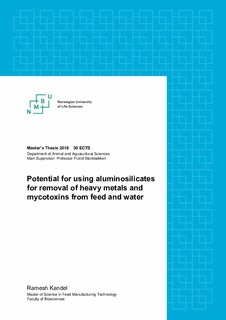| dc.description.abstract | Mycotoxins are naturally occurring secondary fungal metabolites capable of producing toxic effects in humans and animals. The complexion of toxic effects of mycotoxins depend on the chemical structure of the toxin, duration of exposure, and concentration present in food/feed. The most studied mycotoxins are aflatoxins, trichothecenes, zearalenone, and fumonisins. Animals exposed to low levels of mycotoxins show signs of reduced feed intake and weight gain, decreased immunity and overall productivity leading to economic losses. Different physical, chemical, and biological methods to prevent mycotoxicosis in animals have been reported but practical and cost-effective methods for efficiently decontaminating mycotoxins containing feedstuffs are currently not available. The addition of non-nutritive inert adsorbents in feeds contaminated with low levels of toxins have shown to sequester mycotoxins and reduce their gastrointestinal absorption. Aluminosilicates owing to their cation exchange capacity are favorable mycotoxin adsorbent in animal feeds contaminated with low levels of toxins. Most of the aluminosilicates tested in-vitro and in-vivo have shown high adsorption against aflatoxins. However, aluminosilicates are not good adsorbent of mycotoxin other than aflatoxins, especially trichothecenes and zearalenone. Newer adsorbents derived from cell wall of the yeast Saccharomyces cerevisiae and lactic acid bacteria have shown effective binding of Fusarium toxins in-vitro. Similarly, microorganisms from rumen of cattle, intestine of pigs and chickens, and some soil bacterium have shown effective bio-transformation activities against Fusarium toxins. Further animal studies using newer adsorbents or mycotoxin modifiers are needed to demonstrate mycotoxin removal capabilities in-vivo. | nb_NO |

